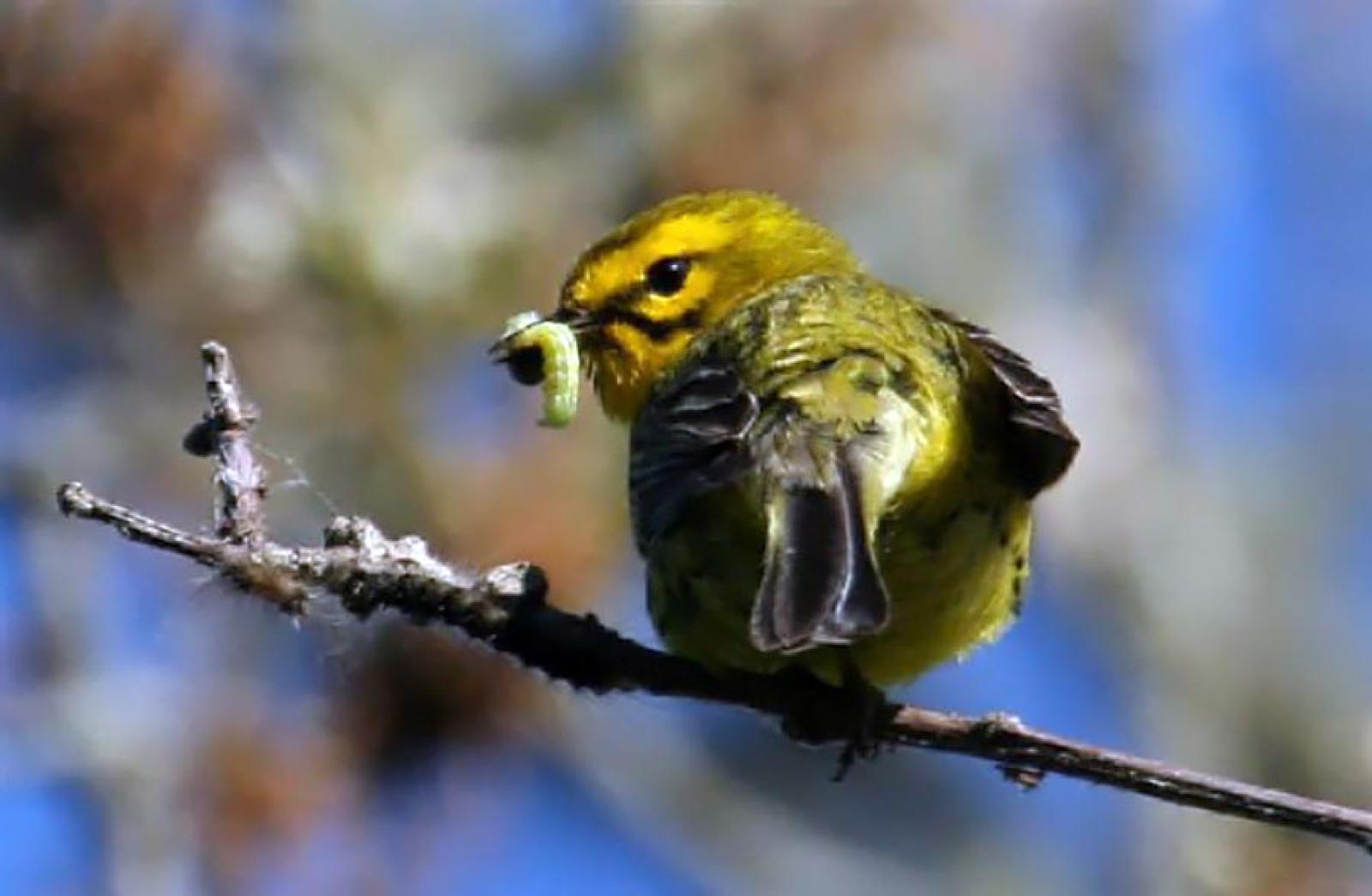Visions of wide open spaces are what one thinks of when they hear the name prairie warbler. Unfortunately, this lovely yellowish warbler has not been named appropriately. Dendroica discolor is the prairie warbler’s Latin name. Loosely translated, this Latin moniker means multicolored dweller of trees. Now that aptly describes the prairie warbler. How prairie got into the mix remains a puzzle to me.
Arthur Cleveland Bent, a ornithologist of yore, theorized that Audubon first spotted the prairie warbler in the “flat, grassy lands among scattered trees in the southern states in the winter.” Mr. Bent continued to say that Audubon didn’t know this warbler very well.
The prairie warbler prefers overgrown fields, scrub oak, pine or second-growth woods for nesting and foraging, not prairies. The males of this warbler usually show up on the Vineyard in early May and perch on top of a scrub or tree and sing zee, zee, zee, zee, zee, zeet to attract a mate. It has been rumored that the male prairie warblers can often have more than one mate. Unlike the females, the males return to the same territory each year and when a female comes to their call, the male performs an elegant display flight that resembles a butterfly. The male has also been observed chasing females around his territory. I think I would prefer the butterfly approach.
The female prairie warbler is the one to choose the nest site, which is usually fairly low in a tree. The shape of the nest is an open cup which is very soft as it is lined with plant down such as dandelion fluff and animal hair. The location of the nest depends on the spring weather. If it is a cold spring and there isn’t much foliage when the females arrive, the nests are more likely to be in evergreens such as juniper, pines or hollies. If there are leaves on scrub oaks, viburnums or other shrubs, the nest is built in one of these. The female lays three to five eggs, which are off white with rusty red speckles. Fourteen days after the eggs are laid, the young hatch and 10 days later they fledge.
There has been a prairie warbler at five corners on Quansoo Road as long as I can remember. I can’t hear it, but recently Rick Stanton, a staff member of the Massachusetts Coastal Waterbird Program, heard the prairie warbler singing away at the same location. I was concerned that the bird had either died or had given up due to brown-headed cowbird parasitism. Unfortunately prairie warblers are very susceptible to cowbird parasitism and cowbirds have increased on the Vineyard over the last 25 years. On Chappaquiddick they were not present until 1953 and now they are there in numbers.
It was nice to hear that the prairie warbler is still on territory on the Quansoo Road and hopefully can produce young without interference from the cowbirds.
Bird Sightings
The peacock is still on walkabout. The bird was last seen at Abel’s Hill at the Hans Solmssen house on June 16.
Sad news from Felix Neck: it seems that the osprey nest has failed. Suzan Bellincampi has gotten in touch with Rob Bierregaard to try to determine what happened. The young hatched May 3 and were fed for a while. Then the parents quit feeding the young or tending the nest. At the nest at Quansoo on Big Sandy, there have been no birds all spring and summer. Now there are three birds all hassling each other. Suzan said there have been three to five birds around the Felix Neck osprey pole as well. Curious.
Back on May 24, Sally Anderson spotted a yellow and red tanager at Waskosim’s Rock. There has been some discussion as to its identity. Sally heard the bird call and it was not a scarlet tanager, but was sure it was the call of a summer tanager. I am unaware of a red and yellow plumage in scarlet tanagers, just summer. This is a late date for a summer tanager.
Sam and Gretchen Feldman of Chilmark are pleased to announce that after three years of watching an empty barn owl box, they are now the “grandparents” of at least one barn owlet and a pair of barn owls. Enjoy.
Rob and Wendy Culbert had a successful birding tour on June 14. They started at the regional high school and the first birds they spotted were a pair of killdeer and two chicks near the baseball diamond. At Thimble Farm they spotted Baltimore orioles, eastern phoebe, eastern kingbird, three more killdeer, oven bird, yellow warbler and common yellowthroat. They also had two male indigo buntings singing and obtained a great look at a yellow-billed cuckoo. Other birds at Thimble Farm included great-crested flycatcher, song and chipping sparrows.
At the Oak Bluffs pumping station there were two black-crowned night herons and a great blue heron.
On June 15, Rob, Wendy and daughter Anne went to Lambert’s Cove beach and spotted black and white warblers, American redstarts, yellow warblers and common yellowthroats. They had four species of swallows, barn, bank, rough-winged and tree.
Dale Carter called to report cedar waxwings at her yard on Chappaquiddick on June 8. Yes, cedar waxwings are here year-round. Pete Cruikshank reported a female pheasant at Mink Meadows on June 15.
Rich Stanton and Stephanie Kelliher have been reporting dickie birds as well as the shorebirds they are observing for the Massachusetts Coastal Waterbird Program.
Sightings of interest by Rich Stanton include: May 15, a black skimmer at Sarson’s Island; also on May 15, 12 black-bellied plovers at Black Point Pond in non-breeding plumage which were gone by June 1; on June 2, Eastern wood pewee at Long Point; and on June 3, a pair of yellow-billed cuckoos at Hoff Farm on Lambert’s Cove Road.





Comments
Comment policy »